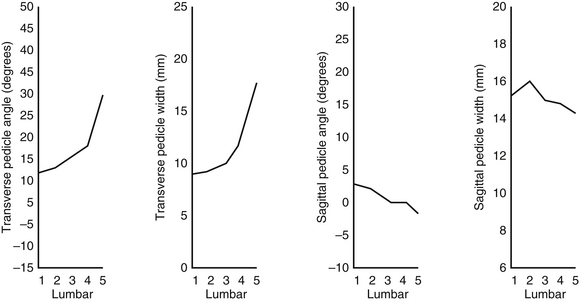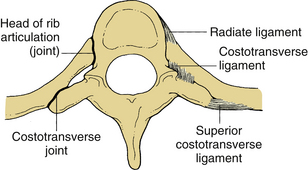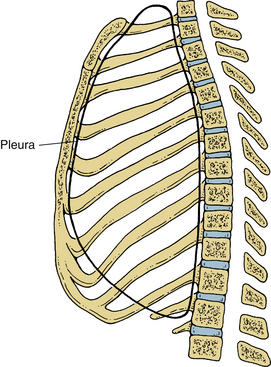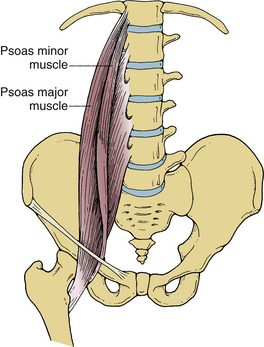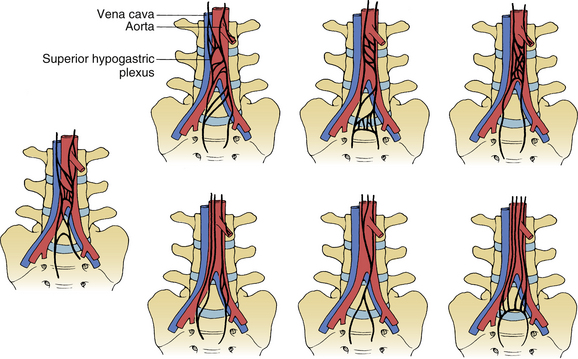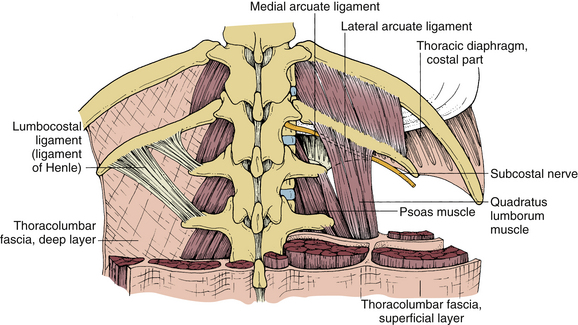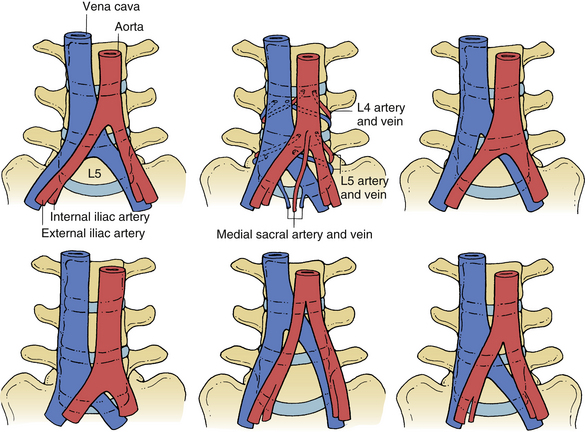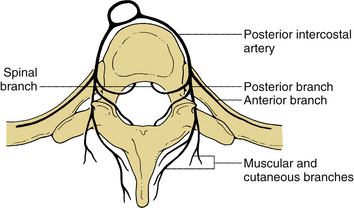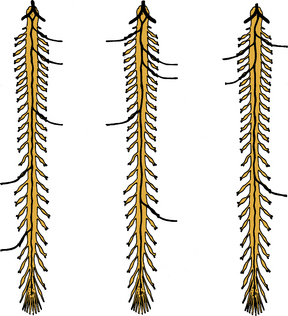Chapter 36 Lumbar and Sacral Spine
Anatomy
Osseous Anatomy
In the lumbar spine, the large osseous ring that surrounds the spinal canal is bordered ventrally by a cancellous cylindric mass (the vertebral body), dorsally by the vertebral arch, and dorsolaterally by the pedicles. Three other key vertebral elements are located near the pedicle and laminae: transverse process and superior and inferior articular processes. With its neural and bony relationships, the pedicle is key to conceptualizing the lumbar spine. The pedicles are wide and thick and are widely spaced on the rostral dorsolateral aspect of the body. In the rostral/caudal dimension, their height is one-half that of the vertebral body. The angles in the transverse and sagittal planes increase and decrease, respectively, as the lumbar spine is descended1 (Fig. 36-1).
The articular processes bear complementary relationships rostrally and caudally. The rostral facet is concave and faces dorsomedially to meet the caudal facet from above. The caudal facet, an extension of the lumina, faces ventrolaterally and complements the superior articulating facet of the vertebral body below. The junction of the two facets forms the roof of the neural foramina (Fig. 36-2).
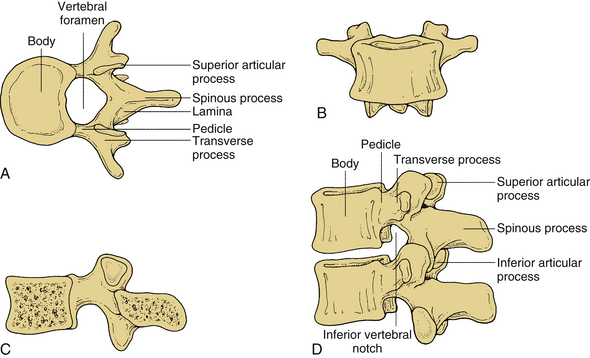
FIGURE 36-2 A, Lumbar vertebra viewed from above; B, ventral; C, median sagittal; D, in articulation.
The sacrum consists of five fused vertebrae. It has a triangular shape and forms the dorsal aspect of the pelvis. It joins with the fifth lumbar vertebra via the L5-S1 disc and facets. The five fused vertebrae have homologous structures referable to the lumbar spine. The transverse processes are the laterally projecting alae that articulate with the pelvis. A prominent midline dorsal ridge represents the fused spinous processes. More laterally, another ridge forms the sacral articular crest with a functional superior articular process at S1. This facet faces caudally and dorsally. Because of the sacrovertebral angle created by the tilt of the sacrum as it joins the fifth lumbar vertebra, this joint functions to prevent ventral displacement of the lumbar spine on the sacrum. Ventrally, transverse ridges represent fused vertebrae and enclose remnants of intervertebral discs. Foramina dorsally and ventrally provide sites of exit for the ventral and dorsal divisions of the sacral nerves. The sacrum is the most variable portion of the spine. Lengthening or shortening of the lumbar spine by deletion or addition of segments to and from the sacrum is not uncommon2 (Fig. 36-3).
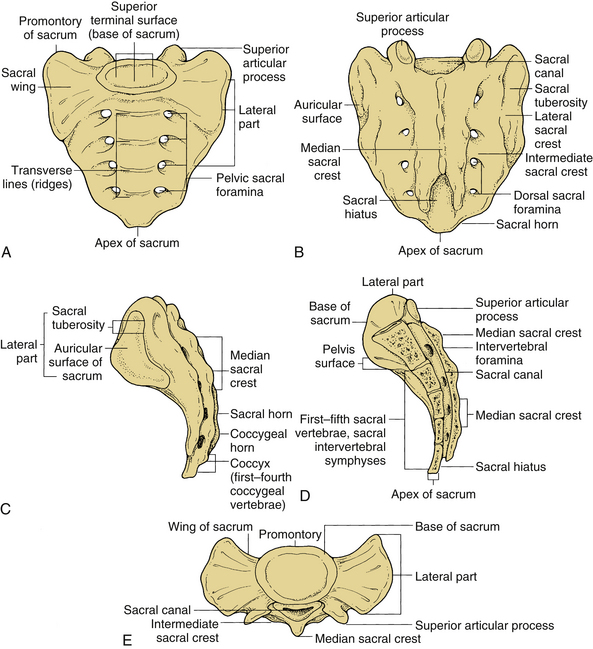
FIGURE 36-3 The sacrum: A, ventral, B, dorsal, C, sagittal, D, medial sagittal, and E, rostral views.
Thoracic vertebrae T2-9 have points of articulations for each rib: one on the vertebral body and the other on the corresponding transverse process. T11 and T12 have a single costal facet on their pedicles (Fig. 36-4). The typical rib has a head, a neck, a tubercle, and a shaft or body. The crest of the head is joined to the intervertebral disc by an intra-articular ligament with two surface articulations: one on the numerically corresponding vertebra and one on the vertebra above it. The neck is the nonarticulating portion of rib between the head and tubercle. The tubercle is on the dorsal portion of the rib at the junction of the neck and shaft. The tubercle of most ribs has a smooth convex facet that articulates with the transverse process of the corresponding vertebra and a rough nonarticular surface to which the lateral costotransverse ligament attaches. The body of the rib is thin and flat, with its greatest diameter in the rostral to caudal orientation. The point of greatest curvature is called the angle of the rib. The costal groove and the flange formed by the caudal border of the rib accommodate and protect the intercostal vessels and nerve that accompany the rib. The 11th and 12th ribs are short and capped with cartilage. They have a single facet on their heads and no neck or tubercle. The 11th rib has a slight angle and a shallow costal groove. The 12th rib has neither of these features. Minet3 classifies the 12th rib as long, medium, or short. The long type is parallel to the 11th rib, and the short type is horizontal and less oblique than the long type. For thoracolumbar surgery, it is important to understand the relationship of the pleural sac to the 12th rib. The pleural sac passes caudally over the inferior border to the 12th rib and continues in this direction for 1 to 2 cm. From there it passes horizontally, crossing caudally, and 3 to 4 cm lateral to the 12th rib head, it continues to pass along the 12th rib for another 7 to 8 cm3 (Fig. 36-5).
Lumbar Spine
Muscles and Ligaments
The intrinsic and extrinsic musculature adjacent to the spine is commonly dissected in approaches to the spine and provides important landmarks in specific approaches. Intrinsic muscles consist of the erector spinae, multifidus, quadratus lumborum, and deep muscles. The large erector spinae muscle is divided into three columns: iliocostalis, longissimus, and spinalis muscles. The iliocostalis muscle, as its name indicates, is the most lateral of the group and arises from the iliac crest and inserts into the ribs. The longissimus muscle, intermediate in the column, runs between the transverse processes of the vertebrae. The spinalis muscle, the most medial, inserts and attaches to spinous processes in the lumbar and thoracic region. All three columns of the erector spinae muscle extend the vertebral column and bend the vertebral column laterally.
Central to the erector spinae muscles are several short muscles that interconnect adjacent and nearby vertebral bodies. This group of small muscles, called the multifidus muscles, originates on the mamillary processes of the rostral facets and runs rostrally and medially to insert on the spinous processes of vertebrae two to four segments above. The quadratus lumborum muscle is located ventral and lateral to the erector spinae muscles. This muscle originates on the iliac crest and iliolumbar ligament and runs obliquely to insert ventrally on the lowest rib and transverse processes of the upper four lumbar vertebrae. Ventral and medial to this muscle are the small intertransversarius muscles that span the transverse processes. Ventrolateral and adjacent to the lumbar vertebral bodies are the psoas muscles, which originate from the lateral aspects of the vertebral bodies and transverse processes of L1-5 and pass through the pelvis and into the thigh dorsal to the posterior inguinal ligament (Figs. 36-6 and 36-7).
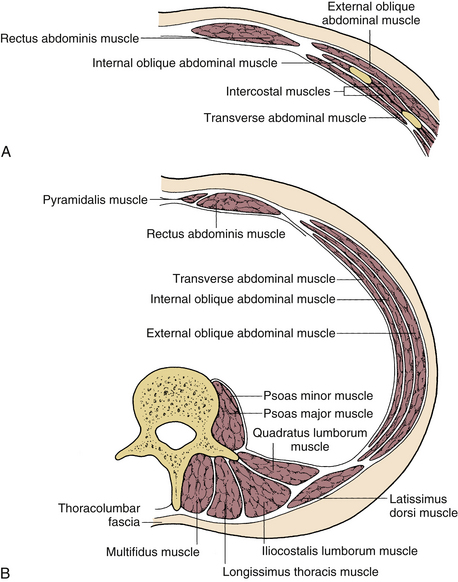
FIGURE 36-7 Coronal sections through the thoracoabdominal musculature above (A) and below (B) the umbilicus.
The extrinsic musculature consists of the rectus abdominis, external oblique, internal oblique, transversalis, latissimus dorsi, and serratus dorsalis caudalis muscles (see Fig. 36-7). The rectus muscles run bilaterally on the ventral abdominal wall from the pubis to the middle ribs. The internal and external oblique muscles and the transversalis muscles are layered superficial to deep as described. They arise from the ribs and thoracodorsal fascia dorsally and insert on the iliac crest caudally and the linea alba medially. The latissimus muscle is a large and diffuse muscle that originates on the sacrum, dorsal iliac crest, and 10th, 11th, and 12th ribs. The fibers in the costoiliac interval run rostrally and laterally. The serratus dorsalis caudalis muscle originates from the lower four ribs, runs caudally and medially, and inserts on the thoracolumbar fascia ventral to the latissimus dorsi muscle.
Exiting Nerve Roots
The lumbar plexus is formed within the psoas major muscle. The largest and most important branches of the lumbar plexus are the obturator and femoral nerves (L2, L3, and L4). The ilioinguinal and iliohypogastric nerves are derived from L1, enter the abdomen dorsal to the medial arcuate ligament, and pass inferolaterally, ventral to the quadratus lumborum muscle, piercing it near the anterior superior iliac spine. The genitofemoral nerve (L1 and L2) pierces the fascia iliaca and the ventral surface of the psoas major muscle and divides lateral to the common and external iliac arteries into two femoral and genital branches. The lumbosacral trunk (L4 and L5) is a large, flat nerve, from which the L4 component descends through the psoas major muscle on the medial part of the transverse process of the L5 vertebra and passes closely over the ala of the sacrum to join the first sacral nerve (Fig. 36-8).
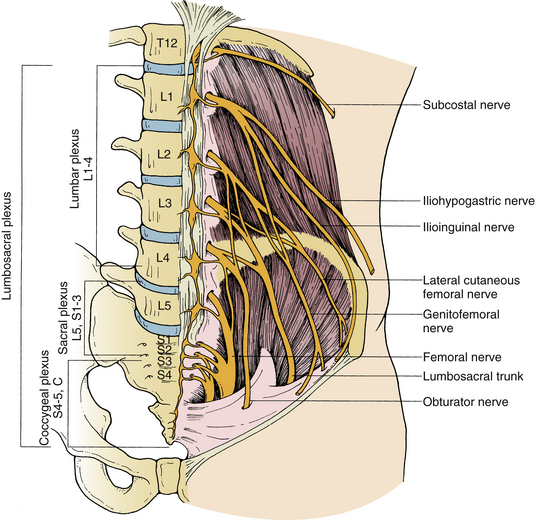
FIGURE 36-8 Anatomic representation of the lumbosacral plexus with the psoas muscle removed on one side.
The sympathetic and parasympathetic nerves are distributed to the abdominal viscera via a tangle of plexuses and ganglia located on the ventral surface of the aorta. The principal components of this system are the celiac plexus ganglia, which are located on each side of the celiac trunk at the level of the rostral aspect of the first lumbar vertebra. The greater, lesser, and lowest splanchnic nerves are branches of thoracic sympathetic ganglia 5 to 12. The hypogastric plexus runs on the ventral surface of the aorta. It receives contributions from the lateral rami of the right and left lumbar sympathetic trunks and from median rami of the celiac plexus and the superior and inferior mesenteric plexuses. It spans the distance from the fourth lumbar to the first sacral vertebra. Its shape and bifurcations can be variable.4 In males the plexus innervates the bladder, vas deferens, and seminal vesicles and is important in the neurophysiology of ejaculation (Fig. 36-9).
Soft Tissue Structures
The thoracolumbar junction is one of the more complicated areas of the vertebral column and has important soft tissue anatomic structures that require special attention. The thoracolumbar fascia is made up of dorsal, intermediate, and ventral layers. The dorsal layer surrounds the erector spinae muscles dorsally. It arises with the tendon of the latissimus dorsi on the sacrum and iliac crest and attaches on the spinous processes of the lumbar vertebrae. The intermediate layer of the thoracolumbar fascia attaches to all of the transverse processes of the lumber vertebrae and to the caudal border of the 12 rib. The lumbocostal ligament of Henle arises from the transverse process of L1 and runs rostrolaterally, inserting to the caudal border of the 12th rib close to its medial end. The ventral layer of the thoracolumbar fascia is attached to the lateral arcuate ligament rostrally, to the iliac crest caudally, to the transversalis fascias laterally, and to the psoas fascia medially. This layer covers the quadratus lumborum muscle and is in contact with the retroperitoneal contents5 (Fig. 36-10; see also Figs. 36-6 to 36-9).
The diaphragm consists of a muscular portion and a central aponeurosis termed the central tendon, on which the muscular portion converges (Fig. 36-11). The muscular portion is divided into three parts on the basis of its fibers’ origins: sternal, costal, and lumbar. The sternal part of the diaphragm arises from the xiphoid process. The costal part of the diaphragm arises from the internal surface of the caudal six ribs at the costal margin. The lumbar part of the diaphragm arises from the lumbar vertebrae by two crura and three arcuate ligaments. The musculotendinous crura envelop the aorta and attach ventrolaterally to the rostral two lumbar vertebral bodies on the left and the upper three on the right. The crura blend with the anterior longitudinal ligament of the lumbar spine. Three arcuate ligaments give rise to fibers of the diaphragm. The median arcuate ligament unites the medial sides of the two crura. The medial arcuate ligament on each side is a thickening of the ventral thoracolumbar fascia over the rostral part of the psoas muscle. From the medial insertion on the vertebral body, it runs over the psoas and has an attachment to the transverse process of the first lumbar vertebra. The lateral arcuate ligament is a thickening of the anterior thoracolumbar fascia running over the rostral aspect of the quadratus lumborum muscle forming attachments to the 12th rib and transverse process of the first lumbar vertebra.6
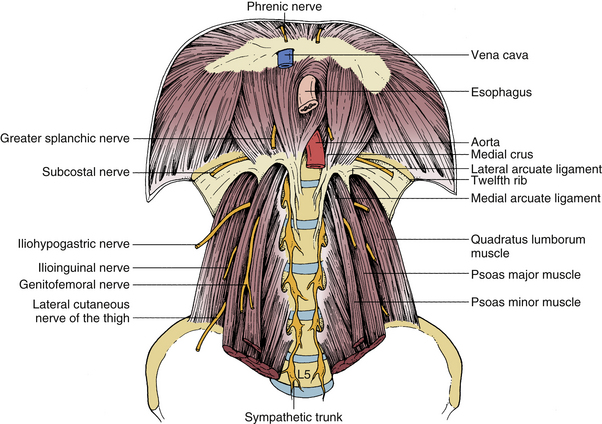
FIGURE 36-11 Anatomic representation of the diaphragm in relationship to lumbar spine and intimate structures.
The abdominal aorta begins at the aortic hiatus in the diaphragm at the level of the T12-L1 intervertebral disc and ends at about the level of L4 by dividing into the two common iliac arteries. The inferior vena cava begins ventral to the fifth lumbar vertebra by the union of the common iliac veins and ascends to the right of the median plane. It pierces the central tendon of the diaphragm at the level of the eighth thoracic vertebra. Five anatomic variants of the aortocaval axis are outlined according to the level of bifurcation and origin of the aorta and vena cava, respectively7 (Fig. 36-12). The aorta is ventral to the vena cava and lumbar vertebral bodies and sits slightly to the left, and the vena cava is located slightly to the right.
The branches of the abdominal aorta may be grouped into four types: (1) those arising rostrally to the celiac (T12), superior mesenteric (L1), and inferior mesenteric (L3) arteries; (2) those arising laterally—the renal (L1), the middle suprarenal (L1), and the testicular or ovarian (L2) arteries; (3) those arising dorsolaterally—the parietal branches of the inferior phrenic arteries, which give rise to the superior suprarenal arteries and the four pairs of lumbar arteries; and (4) an unpaired parietal artery, the sacral artery, which arises from the dorsal surface of the aorta just proximal to its bifurcation (Fig. 36-13). The lumbar arteries pass dorsomedially. On the right they run dorsal to the inferior vena cava, dividing between the transverse processes into the ventral and dorsal branches. The ventral branch passes deep to the quadratus lumborum muscle to anastomose with the inferior epigastric arteries. Each dorsal branch passes dorsally lateral to the articular processes and supplies the spinal cord, cauda equina, meninges, erector spinae muscles, and overlying skin.8 The radicular arteries, which supply blood to the posterior and anterior spinal arteries, arise from these dorsal branches. The largest of these, the arteria radicularis magna (spinal artery of Adamkiewicz), supplies most of the blood to the caudal spinal cord including the lumbosacral enlargement (Figs. 36-14 and 36-15).
Tributaries of the inferior vena cava are the common iliac veins (L5), the lumbar veins, the right testicular or ovarian vein (the left drains into the left renal vein), the renal veins, the azygos vein, the right suprarenal vein (the left also drains into the renal vein), the inferior phrenic veins, and the hepatic veins. The lumbar veins consist of four or five segmental pairs. They may drain separately into the inferior vena cava or the common iliac vein, but they are usually united on each side by a vertical connecting vein, the ascending lumbar vein that lies dorsal to the psoas major muscle. Each ascending lumbar vein passes dorsal to the medial arcuate ligament of the diaphragm to enter the thorax. The right ascending lumbar vein joins the right subcostal vein to form the azygos vein, and the left subcostal vein forms the hemiazygos vein.6
Each kidney lies dorsal to the peritoneum on the dorsal abdominal wall. The kidneys lie along the vertebral column against the psoas muscle. The ureter is retroperitoneal throughout its length. It adheres to the peritoneum and is usually retracted with it during retroperitoneal approaches to the spine. The ureter descends nearly vertically along the psoas major muscle. On the right, it is next to the vena cava, and on both sides, it crosses the brim of the pelvis and the external iliac artery, just beyond the bifurcation of the common iliac artery.
